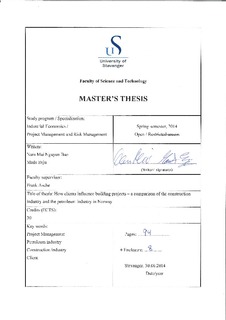| dc.contributor.author | Evju, Mads | |
| dc.contributor.author | Mai, Nam Bao Nguyen | |
| dc.date.accessioned | 2014-10-07T08:44:21Z | |
| dc.date.available | 2014-10-07T08:44:21Z | |
| dc.date.issued | 2014-06-30 | |
| dc.identifier.uri | http://hdl.handle.net/11250/223224 | |
| dc.description | Master's thesis in Industrial economics | nb_NO |
| dc.description.abstract | Several studies indicate the need for competence and quality improvement in the Norwegian construction industry. Findings show that diversity in client groups can lead to different levels of competence. This poses many challenges to the industry and those involved, all of which will be highlighted in this thesis.
The objective of this thesis is to provide an understanding of how clients’ levels of competence and focus can influence the final results of building projects. This thesis provides a comparison between the Norwegian construction industry and the Norwegian petroleum industry in order to exemplify the findings and provide a solid basis for recommendations for the construction industry.
Ten in-depth interviews with various people from contracting companies and consulting firms within both industries have been performed. Information pertaining the clients, along with general practices for planning and control in the industries have been addressed and categorized. It is further analyzed how differences in client competence and focus affect practices for planning and control, and in turn, how this impacts the projects.
The research has addressed several differences in practices for planning and control in projects of the two industries. Projects in the construction industry seem to be executed with less planning and control, which in many cases can be led back to poor competence among clients. The analysis shows how insufficient planning and control give rise to late changes, resulting in re-building expenses and in turn affects the project results. Poor competence among clients will also have a direct impact on the projects through late client-initiated changes. The research underlines that the construction industry has great potential for quality enhancement, and a lift in the competence level among clients is likely to give both quality improvements and higher project profitability. Compulsory arrangements are considered to be the most effective approach to meet this challenge, meaning that the Norwegian Government needs to take the final responsibility for implementing sufficient measures in the future. | nb_NO |
| dc.language.iso | eng | nb_NO |
| dc.publisher | University of Stavanger, Norway | nb_NO |
| dc.relation.ispartofseries | Masteroppgave/UIS-TN-IØRP/2014; | |
| dc.rights | Attribution-NoDerivs 3.0 Norway | * |
| dc.rights.uri | http://creativecommons.org/licenses/by-nd/3.0/no/ | * |
| dc.subject | prosjektledelse | nb_NO |
| dc.subject | project management | nb_NO |
| dc.subject | petroleum industry | nb_NO |
| dc.subject | construction industry | nb_NO |
| dc.subject | industriell økonomi | nb_NO |
| dc.title | How clients influence building projects - a comparison of the construction industry and the petroleum industry in Norway | nb_NO |
| dc.type | Master thesis | nb_NO |
| dc.subject.nsi | VDP::Social science: 200::Economics: 210 | nb_NO |

